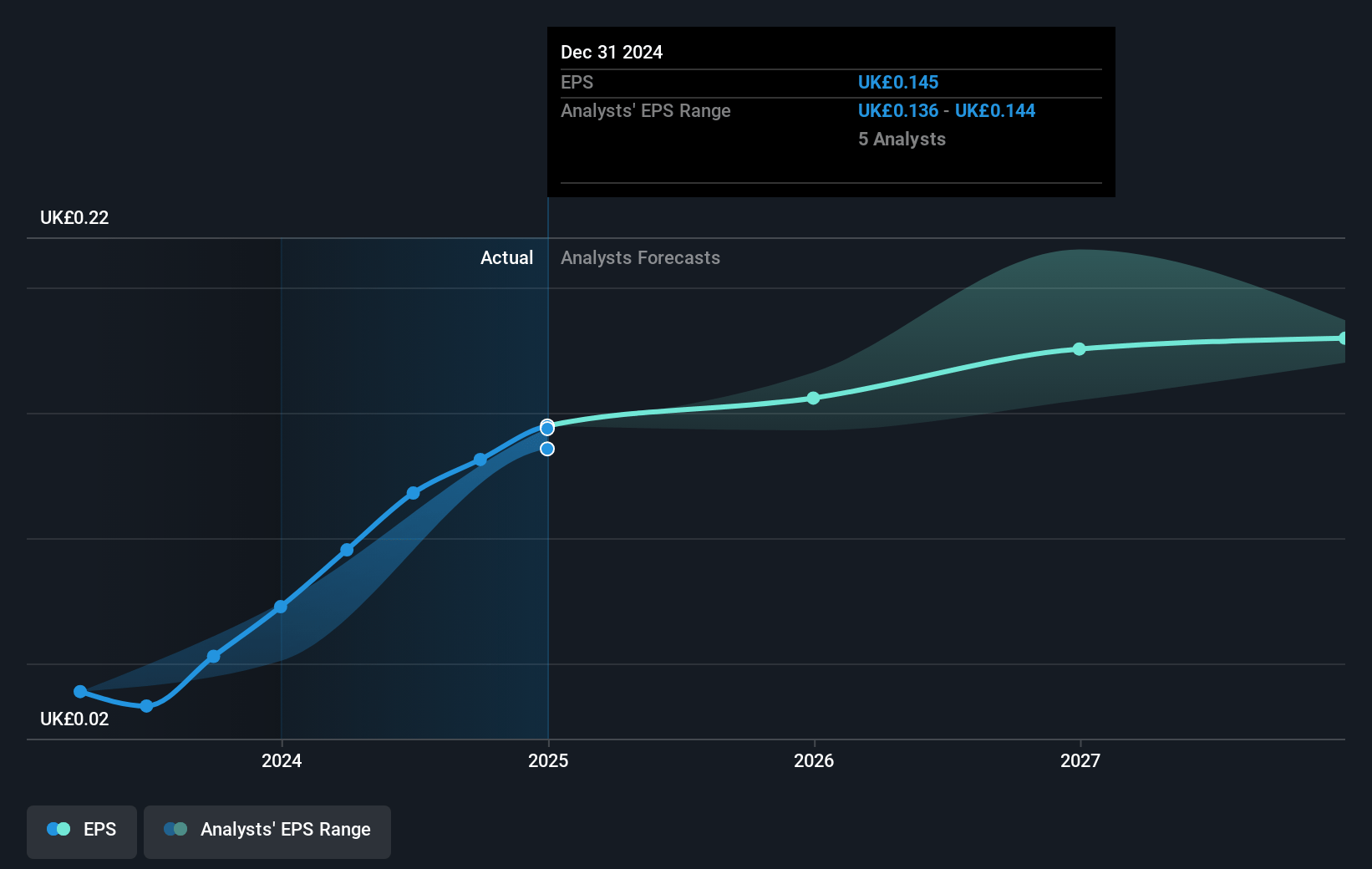Key Takeaways
- Expansion into motorcycle insurance and Sabre Direct could diversify revenue streams and improve operational efficiency, enhancing future revenues and net margins.
- Strong capital management, including share buybacks, is likely to increase earnings per share and support profit growth initiatives.
- Claims inflation and regulatory changes pose significant risks to Sabre Insurance's margins and profitability, stressing the need for adaptive pricing strategies.
Catalysts
About Sabre Insurance Group- Through its subsidiaries, engages in the writing of general insurance for motor vehicles in the United Kingdom.
- Sabre's launch of the Bike product and expansion into motorcycle insurance represents a new revenue stream, potentially increasing future revenues as this segment grows.
- The implementation of Sabre Direct for motorcycles and the testing of new car pricing are expected to improve operational efficiency, which should lead to improved net margins.
- The focus on maintaining strong pricing amidst claims inflation and underpricing by competitors suggests potential margin improvement as market conditions normalize, impacting earnings positively.
- The Ambition 2030 initiative, aiming for significant profit growth, includes expanding into core car and motorcycle markets, which could lead to increased revenues and a more diversified earnings base.
- The recent share buyback and strong capital position indicate robust capital management, potentially leading to improved earnings per share due to the reduced number of shares outstanding.
Sabre Insurance Group Future Earnings and Revenue Growth
Assumptions
How have these above catalysts been quantified?- Analysts are assuming Sabre Insurance Group's revenue will grow by 9.1% annually over the next 3 years.
- Analysts assume that profit margins will shrink from 16.5% today to 16.2% in 3 years time.
- Analysts expect earnings to reach £45.8 million (and earnings per share of £0.18) by about April 2028, up from £36.0 million today. The analysts are largely in agreement about this estimate.
- In order for the above numbers to justify the analysts price target, the company would need to trade at a PE ratio of 11.8x on those 2028 earnings, up from 9.8x today. This future PE is greater than the current PE for the GB Insurance industry at 11.7x.
- Analysts expect the number of shares outstanding to decline by 0.17% per year for the next 3 years.
- To value all of this in today's terms, we will use a discount rate of 6.4%, as per the Simply Wall St company report.
Sabre Insurance Group Future Earnings Per Share Growth
Risks
What could happen that would invalidate this narrative?- Claims inflation remains a significant concern, with cost inflation, particularly in major injury claims, expected to continue. This could negatively impact the company's loss ratio and net insurance margins, especially if these costs are not fully accounted for in pricing strategies.
- The competitive market environment poses risks, as Geoff mentions the potential for other insurers to write business at unprofitable margins if prices don't start increasing. This suggests that Sabre Insurance might struggle to maintain their current profit levels if market pricing remains soft, leading to potential pressure on revenue.
- There are concerns about potential regulatory impacts from the FCA premium finance review, which could alter the current state of ancillary income. This could impact the company's revenue streams from non-premium activities, especially if they're mandated to lower APRs or adjust fees.
- Sabre Insurance's strategy to expand into lower-margin, less risky segments of the market might pressure net margins if these sectors prove more competitive or less profitable than anticipated.
- Persistent operational and claims inflation, as noted in the text, alongside adverse reserve development in prior years, suggests ongoing financial risks. If insurance pricing fails to keep pace with these underlying cost increases, this could adversely impact net earnings and profitability.
Valuation
How have all the factors above been brought together to estimate a fair value?- The analysts have a consensus price target of £1.829 for Sabre Insurance Group based on their expectations of its future earnings growth, profit margins and other risk factors. However, there is a degree of disagreement amongst analysts, with the most bullish reporting a price target of £2.05, and the most bearish reporting a price target of just £1.45.
- In order for you to agree with the analyst's consensus, you'd need to believe that by 2028, revenues will be £283.0 million, earnings will come to £45.8 million, and it would be trading on a PE ratio of 11.8x, assuming you use a discount rate of 6.4%.
- Given the current share price of £1.43, the analyst price target of £1.83 is 22.0% higher.
- We always encourage you to reach your own conclusions though. So sense check these analyst numbers against your own assumptions and expectations based on your understanding of the business and what you believe is probable.
How well do narratives help inform your perspective?
Disclaimer
Warren A.I. is a tool utilizing a Large Language Model (LLM) that ingests data on consensus price targets, forecasted revenue and earnings figures, as well as the transcripts of earnings calls to produce qualitative analysis. The narratives produced by Warren A.I. are general in nature and are based solely on analyst data and publicly-available material published by the respective companies. These scenarios are not indicative of the company's future performance and are exploratory in nature. Simply Wall St has no position in the company(s) mentioned. Simply Wall St may provide the securities issuer or related entities with website advertising services for a fee, on an arm's length basis. These relationships have no impact on the way we conduct our business, the content we host, or how our content is served to users. The price targets and estimates used are consensus data, and do not constitute a recommendation to buy or sell any stock, and they do not take account of your objectives, or your financial situation. Note that Warren A.I.'s analysis may not factor in the latest price-sensitive company announcements or qualitative material.




